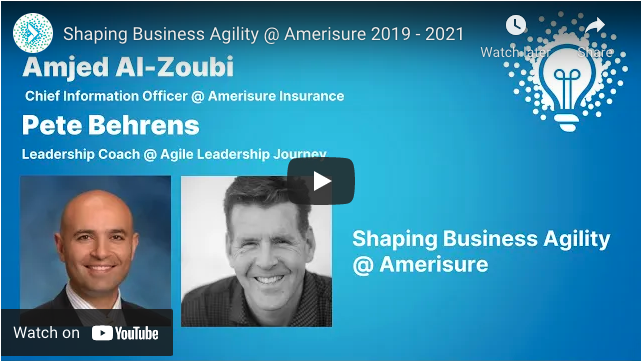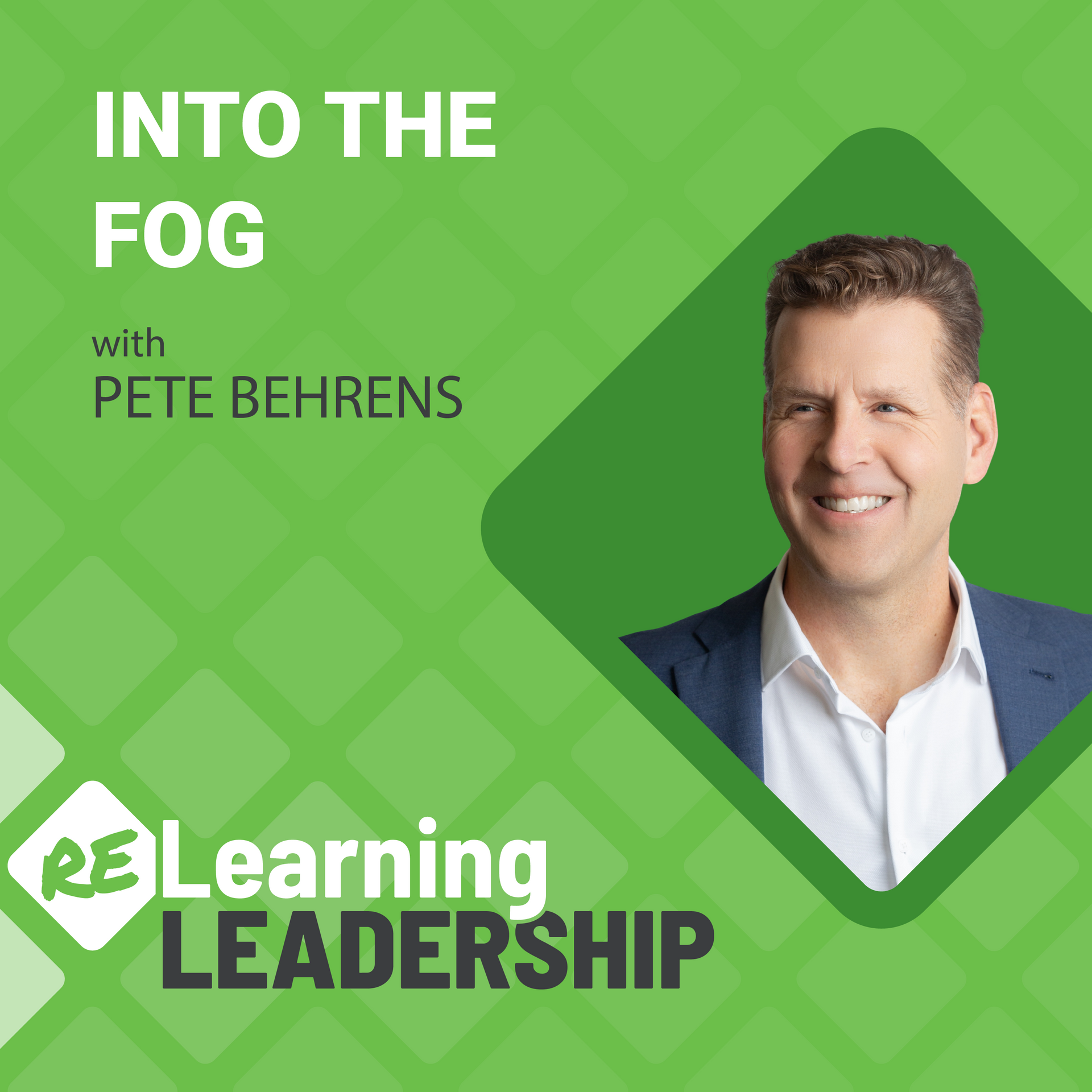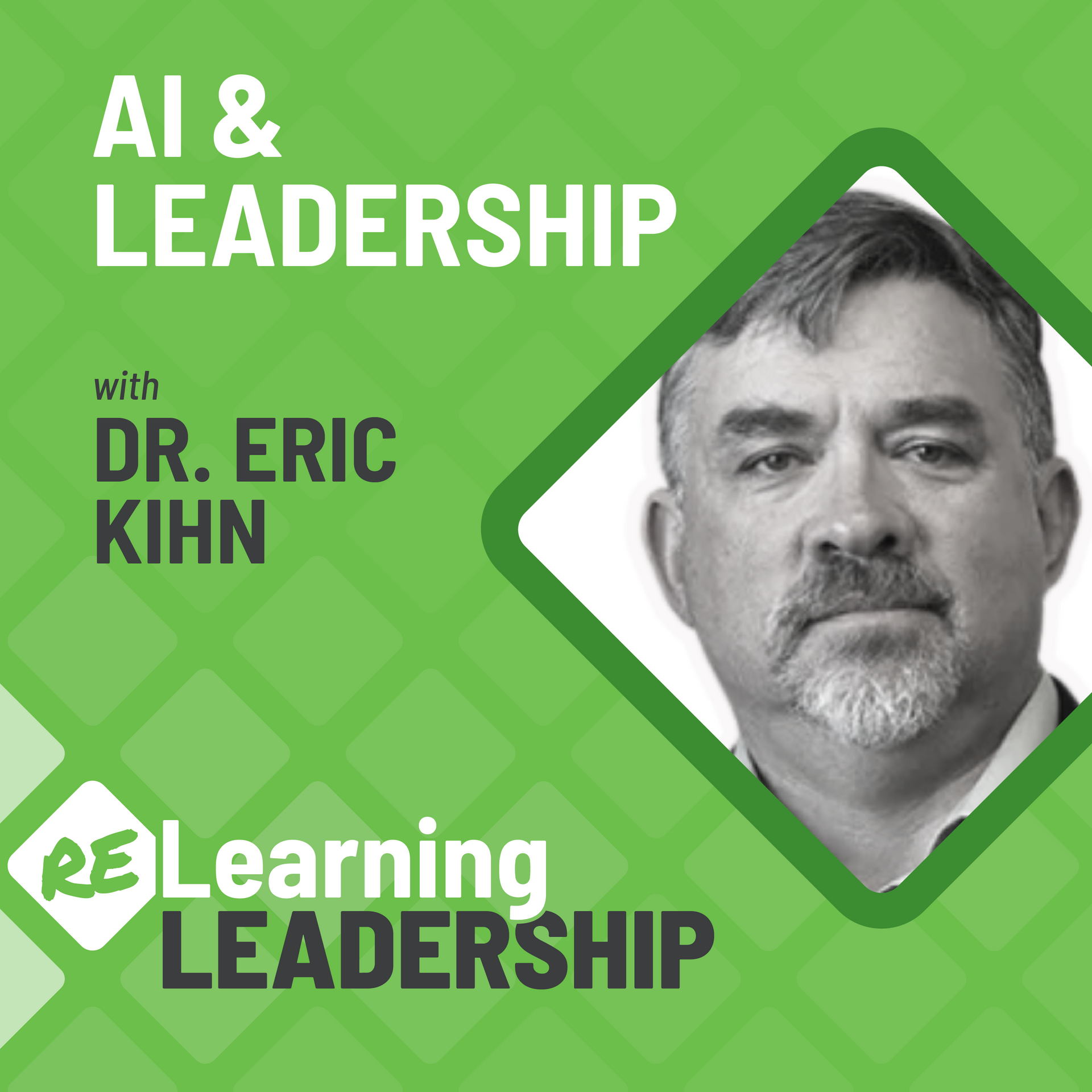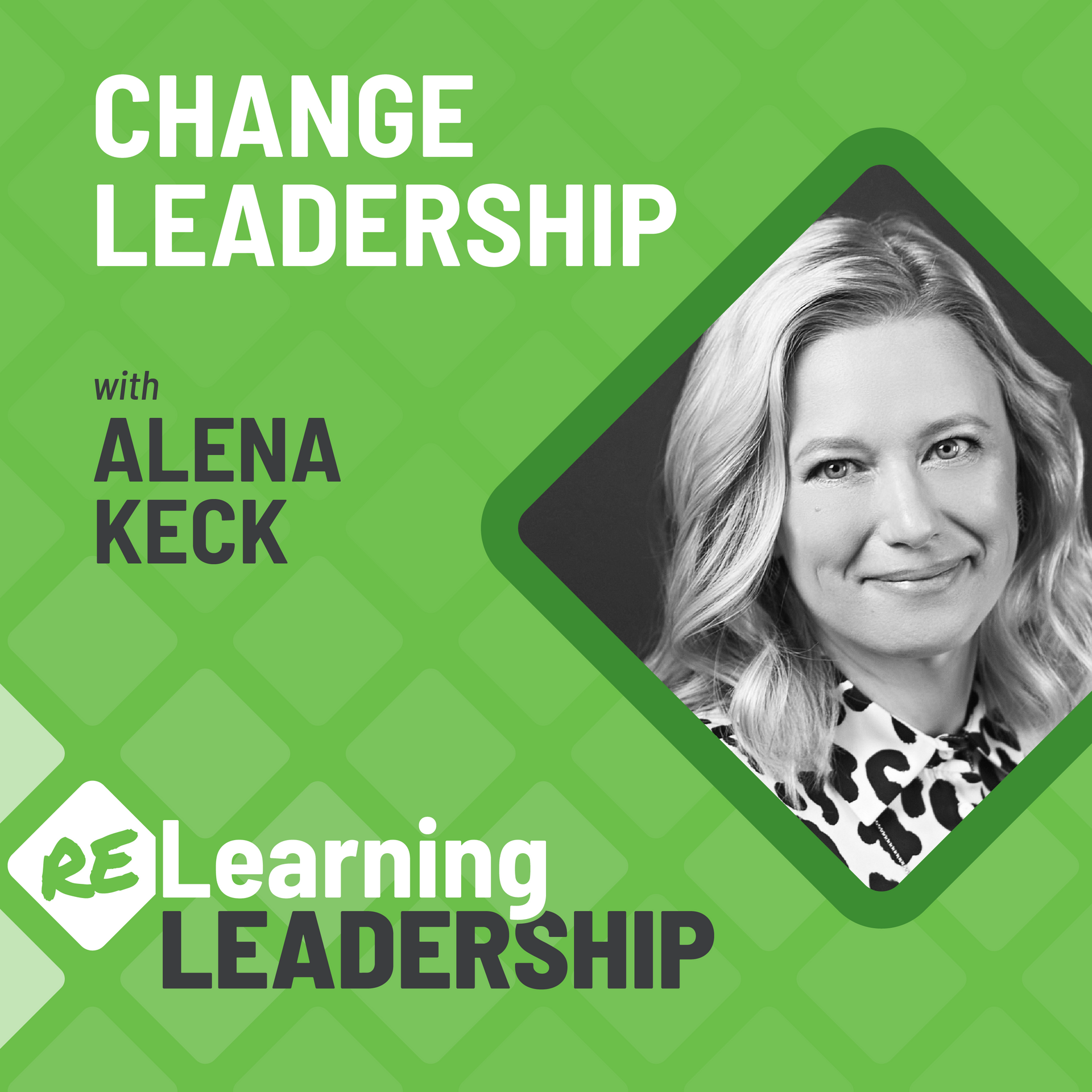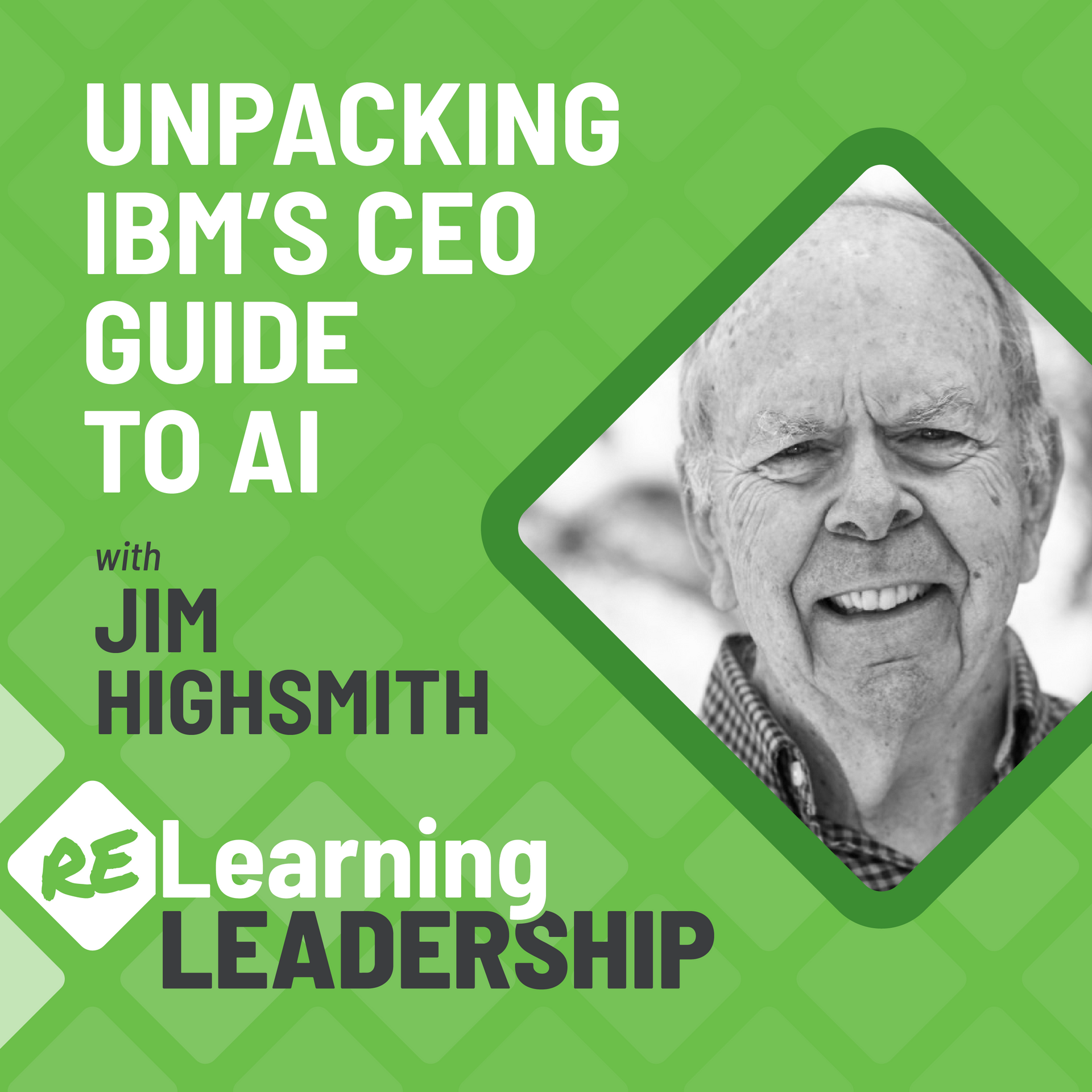26: Talking Transformation
What does it take to guide a multi-year transformation?
Stemming from a proactive recognition from senior leadership, Amerisure Insurance has been on a 3-year culture-shaping journey to improve their speed of innovation. Amjed Al-Zoubi, CIO of Amerisure, and Pete co-presented this case study at the Business Agility Conference in NYC.
In this episode, Pete and Amjed went a little deeper and discussed more about the leader behind the title and about what it’s like to be on such a journey.
Amjed Al-Zoubi, CIO
Amjed Al-Zoubi, CIO of Amerisure, is a strategist and business leader with over 20 years of experience delivering results by bridging the business-technology gap.
Amjed joined Amerisure in 2018 and currently serves as CIO with accountability for IT, Digital, Innovation, Business Agility, and the PMO.
Under his leadership, Amerisure is undergoing an agile cultural transformation, a digital transformation, and is modernizing IT, improving solution delivery and business outcomes.
Connect with Amjed
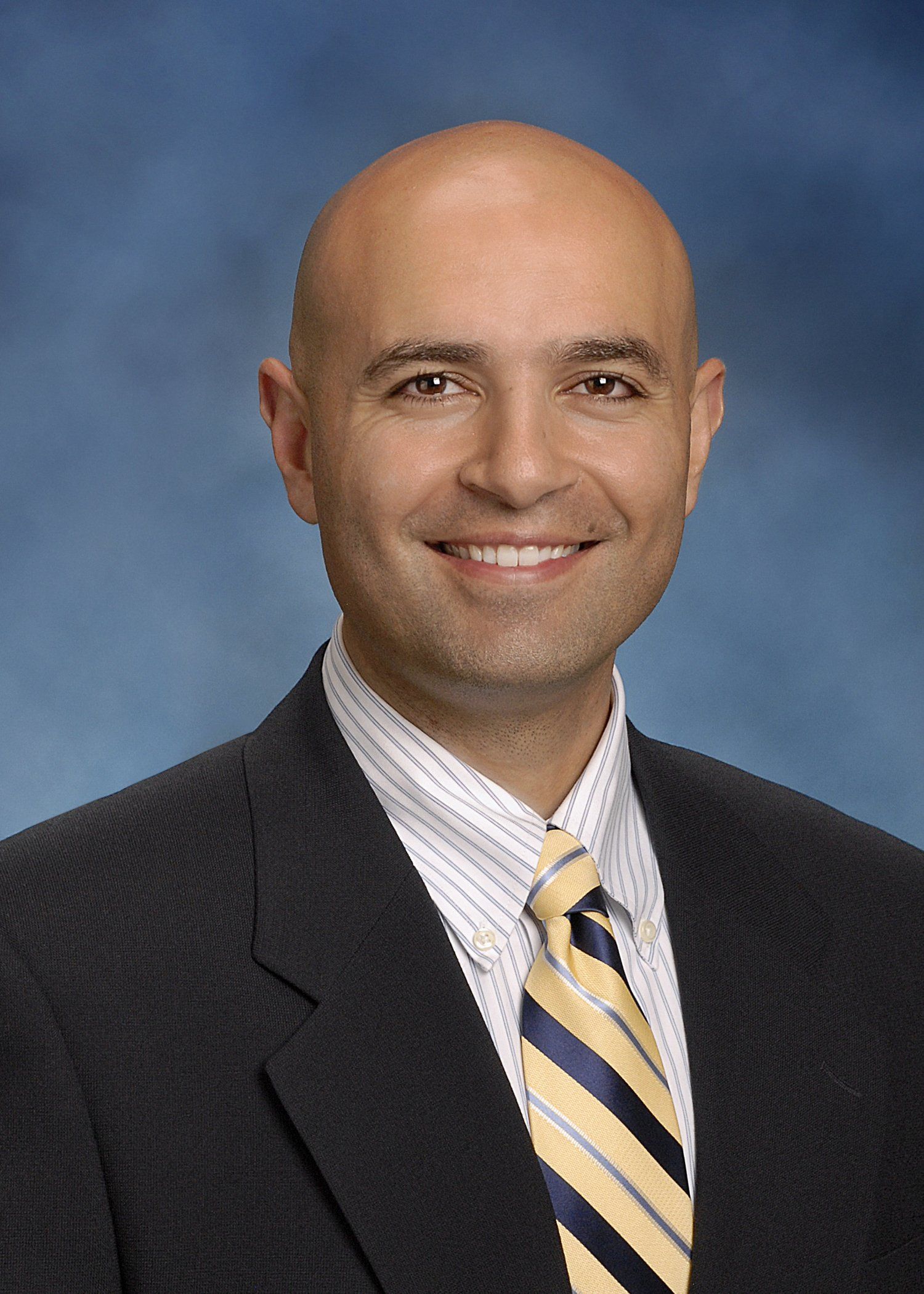
Business Agility Conference Presentation
Amjed and Pete shared Amerisure’s 3-year journey of shaping culture for improved speed of innovaiton at the the 2022 Business Agility Institute Conference in NYC.
Listen to the 20-minute Business Agility Institute Conference Presentation: Shaping Business Agility @ Amerisure.
Relearning from this episode…
It was a pleasure to share the big stage and the small stage with Amjed, and to be able to walk alongside their journey to improved speed of innovation. Here is what I am taking away from our discussion.
Flow Like Water. Oftentimes, the path of least resistance is the optimal path. Pick your battles, and focus your attention on early adopters to create flow and to begin eating away at those bigger boulders.
Show Patience. Leaders are often a few steps ahead of others in the organization. Without a bit of patience, others may quickly become lost or disillusioned.
Pay Dividends. Significant transformation requires time. However, stakeholders have little patience and need to see progress. Find, share, and celebrate wins along the journey to keep the momentum and spirits.
And finally, Share the Driver’s Seat. Life is more fun in the driver’s seat. Seek opportunities to let everyone drive. That means sharing ownership and empowering others to take the controls.
We Celebrate Joy Zimmerman’s Milestone
Joy Zimmerman, the creator of the music you hear on this podcast, is celebrating an award-winning album this summer. The Canvas Before Us reached Top #8 on the International Folk Chart!
Visit Joy Zimmerman Music
For this episode, I connected to one of Joy’s older songs of journey,
Thus Far.
I see Amjed and Amerisure on a journey, and the story they shared today only represents a few steps along that path. Thank you for sharing your story thus far.
Enjoy
Thus Far by Joy Zimmerman.
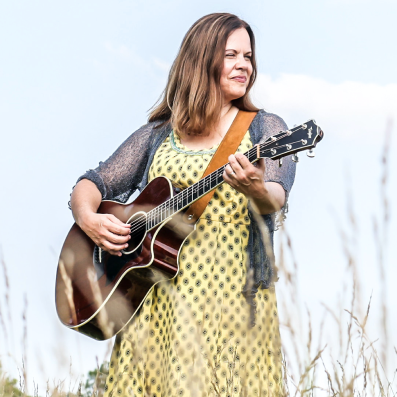
Episode Transcript
Pete Behrens:
What does it take to guide a multi-year transformation?
Welcome to another episode of Relearning Leadership, where we explore a specific leadership challenge and break it down to help improve your leadership, your organization…and even your personal life.
Just prior to this recording, I had the pleasure to share the big stage at the Business Agility Conference in NYC with my guest, Amjed Al-Zoubi, the Chief Information Officer of Amerisure. We co-presented a three-year, culture-shaping journey to improve their speed of innovation. You can watch that video posted on the episode page.
For this discussion, Amjed and I sat down in a more intimate setting to learn more about the leader behind the title.
Amjed Al-Zoubi:
I tend to see the world of—you kind of flow, maybe like water, where you can. And where you can't, you slowly work your way around it. So, eventually water will create a valley and chip away, but it will take the path of least resistance, perhaps.
Pete Behrens:
Thank you for joining us today. Let’s dive in.
Pete Behrens:
Today, I am feeling incredibly fortunate. I think this is the first time I've actually been able to do an in-person interview. Welcome to the show, Amjed!
Amjed Al-Zoubi:
Thanks, Pete! It's great to see you. Great to be here in person as well. The conference has been great as well.
Pete Behrens:
Well, it's really special because we've been able to actually develop and share a case study. And so we'll talk a little bit about that case study, but before we get into all that stuff, maybe I'd just like to know just a little bit more about you. Who is Amjed?
Amjed Al-Zoubi:
Wow, that's a big question to answer and try to distill into something coherent, Pete, but I'll do my best! I guess I'd start with calling myself a pragmatic optimist. I like to think big things and think we can achieve a whole heck of a lot. But we also need to be pragmatic about it. It's got to be achievable, and crazy, big, hairy goals that are not attainable—you give up on too easily. And, you know, that is part of my leadership story, why I am the way I am. And I share that with my teams because, early on in my career, I would charge forward and say,
“Yeah, we can do that!” And some people would have an adverse reaction, like, “Who is this guy?” And they didn't buy into it. They thought I was fake, And so I started to tell my leadership story and why I am the way I am and why I'm a pragmatic optimist. And I apply that to what I do and the teams that I lead, and, well, heck, sometimes we surprise ourselves with what we can do.
Pete Behrens:
I love that term,
pragmatic optimist.
You know, when I think about setting realistic or effective goals, you know, I think about something that is tangible, but stretch, right? Like, it's just out of reach. Is that a fair way of saying that?
Amjed Al-Zoubi:
That's right. That's very fair. Very fair. We say,
“We can do it! We're not exactly sure how, but we think we can!”
And we figured it out.
Pete Behrens:
So, you say that comes from somewhere. So, is there a story behind here that I'm missing still?
Amjed Al-Zoubi:
A little bit of a story. It's not terribly dramatic, but it starts with my dad. My parents—they are from a small village in Jordan called Rumfa. And my dad was the only one of nine kids that went to college in his family. And when he was going to college—his undergrad—he was going to a next town over to go to school. And then after school, he would come back, and he'd work the farm back in the village. And he planted olive trees on the farm to create some income for our family. And he tended to the olive trees while he was in school. He went to Baghdad for his Master's and ended up coming to the US, University of Michigan, for his PhD. And that's what brought our family here.
And so, as I reflect on that story, they gave up a lot to come here, and they took a little bit of a risk, of course, coming to a new country with three kids in tow. There's more kids now, but that was the story at the time. And he achieved a lot through education, and I wasn't going to throw that away. And so that created the learner aspect of me. But the pragmatic piece was—through his journey of coming here, through my journey of growing up, there were things that I could do and couldn't do. There's a culture gap. My parents grew up in Jordan; I grew up here. And so I had to be somewhat pragmatic about, you know, what's the right thing to push on, if you will, if that makes sense. But it really helped me realize that, for certain situations, you really do have to understand where your limits are and pick and choose the battles you want to fight.
Pete Behrens:
I know you just shared with me losing your father a couple years ago. And it's awesome to see him living through you today. And he was probably looking proudly upon you, I can imagine.
Amjed Al-Zoubi:
You're going to make me emotional, Pete.
Pete Behrens:
Well, I imagine there's a lot of listeners who have not achieved that C-level title. As I think about the status and the authority you get from a C-suite—in your case, CIO title—what was that path like for you? What was it like to move through leadership ranks, and is it different up there?
Amjed Al-Zoubi:
I like to say that our careers are winding roads, and we have to be ready for the ride. I think I wrote this down a couple weeks ago, of—if you're not in the driver's seat, it's not that fun. But if you're driving, and you're going through that winding road, it can be a thrill ride. You're going to loop back sometimes. You're going to have setbacks sometimes. So I've had the opportunity to take on new growth roles. I've had the opportunity to take on roles that were less than my previous role. And, of course, that wasn't by choice, but it was what the situation called for. I understood that. In one particular case, for example, I took a title demotion to work for a different leader, and I ended up learning a ton from her. And so, you can always learn from the situation that you're in. Getting that diverse set of experiences really helped position me for whatever the next thing was, thinking differently about problems. And the promotions and the roles and the titles followed. And so that's what I continuously focus on. So that's my story of how I got to where I am. Is it different? I guess a little bit. The positional power, of course, is there, but I still approach things as business problems to solve. And that hasn't changed. And I think that that really helps me connect with folks, no matter what level they're at.
Pete Behrens:
I certainly feel that with you. You know, I feel like you're very down to earth. And, you know, I think a lot of people create their own fear in talking to senior leaders. And that threat is in their brain, regardless of what you do. I think you do a really good job of bringing that down and just creating a rapport that makes people comfortable. So I'd probably give you a little kudos on being able to level set that.
Amjed Al-Zoubi:
Thank you. Yeah. This is a job about people, technology, agility. It's about people and connecting with people, and if we don't have that, then we're not having good conversations.
Pete Behrens:
I love how you're leveraging what we would call that
growth mindset,
right? Taking heat moments, taking difficult situations and saying,
“Hey, you know, we can learn from those!”
I remember our kids in school hating their teachers or, you know, whatever that was. And for us, it was like,
“You know, you're not always going to be able to pick your boss. The only thing you can do is—what are you going to learn from this situation? How do you apply yourself to learning? Because it's not going to be easy for you.” And it sounds like you've applied that to a lot of the steps you've taken, which is pretty cool.
Amjed Al-Zoubi:
Absolutely. And for a while, I did it without even realizing it. It took me reflecting on how people react to my pragmatic optimism to reflect on why am I the way that I am, and does it make sense in this? So it's certainly something that I'm more intentional about, in fact, now that I recognize it.
Pete Behrens:
Well, amazingly, Amjed is a CIO, so that is the technical side of the business, yet you keep talking about people here. And that's really what we're here, you know, sharing a story about, at the business conference—is a culture-shaping story. So, maybe introduce us to this. This started about three years ago, I know, 2018 or so. Even before we met in 2019, what was going on? What kind of sparked a different journey for Amerisure and your role in this journey?
Amjed Al-Zoubi:
I joined Amerisure in June of 2018. And I don't know this for sure, but I think I'm directionally correct. The leadership team there recognized the need to try things differently. And coming from the background that I had, I think they recognized that and picked me for what I can help the company with. And I picked the company because I felt that they were ready for the change. And so, with that matchmaking, we then got into the Fall of 2018, and we started to reflect on what's happening at the company. And the key themes that started to emerge were the challenges of having too much work in flight, too much concurrent work, too few people that knew so much information. Knowledge silos, if you will. The need to get things right the first time. The amount of planning that we have up front. So it really resulted in an inability for us to go fast and to innovate. And we knew with increasing pace of change that that had to be a muscle that we exercised and got stronger. So the time was right. I had some of the experience to help bring it all to the table, but it wasn't a one-person job. It's just the way we came together. The time was right. And then when you joined in, you helped us put words and pictures around what we were hearing and feeling.
Pete Behrens:
Yeah. Well, and to be honest, you weren't even CIO at that point, correct? Is that true?
Amjed Al-Zoubi:
Right. Correct.
Pete Behrens:
And so, yeah, I think it was a team sport. I want to give a shout out to Rob Kahlman from Michigan Technology Services, who did make our connection and services your region and is one of our partners who brought us together. And yeah, so one of the first things that I know we did when we met was to share a view of culture. And I think people listening to this may or may not understand, kind of, what that looks like. But maybe paint us a picture in your mind. How did you see that impact the leadership team?
Amjed Al-Zoubi:
Having a visual representation of our culture really focused our conversation and our discussion on the problem statement. The culture map that we had really emphasized that we had a control culture. And that's what we were feeling. That's what we were talking about. But we started to recognize why
we had that culture, the value in that culture, and the need to balance it out, though. And that's what it's really all about for Amerisure—is finding that balance. And so the conversation we had was,
“Who is Amerisure? What's the best culture for Amerisure?”
And then we could start talking about how to get to that culture. So the map really opened up our eyes for realizing,
“Hey, we can do this, and we can be intentional and purposeful about the type of culture change we want to drive.”
Pete Behrens:
You've said to me openly as well—it wasn't a surprise. You know you're a control culture. It's an insurance company. I mean, safety is your bottom line! But at the same time, what you're saying is maybe seeing it in a slightly different way or seeing how they interconnect between safety and, in this case, innovation and creativity can be a really interesting kind of dynamic.
Amjed Al-Zoubi:
Absolutely. And you start to loosen them up in some cases where you do want to experiment and can take on more risk. Whereas the areas that you don't, with audit, with compliance—you want to retain those controls. With rolling out technology, we can take on a little bit more risk. We can break work down more. And so we were able to pinpoint the things we wanted to do differently. With people, it was creating that safety to experiment, that safety to fail, in smaller batches, if you will. We, of course, don't want the catastrophic failures. We also wanted to limit—maybe even prohibit—the failures from reaching our customers. So at the outset, when we were first getting started, we were very, let's say, pragmatic about our approach of, “These are the things we're going to do and experiment with, and these are what we're not going to do.” And it really helped frame and make folks comfortable with trying this new thing out for us.
Pete Behrens:
Did you find that you, personally, had to change? Or was this pretty natural for you? How did that impact you personally?
Amjed Al-Zoubi:
For me, really, it did come natural, Pete. I tend to see the world of—you kind of flow, maybe like water, where you can. And where you can't, you slowly work your way around it. So, eventually water will create a valley and chip away, but it will take the path of least resistance, perhaps. It was more natural for me to think about,
“Hey, where can we effect change? Where can we create wins? Where can we make it cool to participate so that others thought, ‘Hey, I want to do that thing!’” And when you think like that, you identify folks that are ready and can start that journey with you. And there was a group—our claims organization was really ready for that. And they were a great partner at the outset because they were there ready to try just about any experiment. And they continue to be the model for doing the new things the new way.
Pete Behrens:
Well, why is that? What was the motivation behind there? Can you point to anything particularly created that urgency?
Amjed Al-Zoubi:
From the claims team?
Pete Behrens:
Yeah. Yeah.
Amjed Al-Zoubi:
Wow. You know, I don't know that I've thought about it that way before. The leaders were ready. They had the most advanced technology, and so they were further along in their journey. And they had been doing some of that work before I even got there. So—I don't know—it was maybe taking advantage of the wave and riding that wave a little bit harder.
Pete Behrens:
Well, and I think what you're pointing at is, you know, as leaders, sometimes we get frustrated with the resistors, so we get frustrated with those pushing back. And sometimes it's better to just not deal with that and focus on the receptors, focus on those who are eager, and focus on those early adopters to drive forward. And sometimes those laggards or resistors, you know, are just more hesitant. They're on a later spectrum. And so, by putting all of our energy that way, it kind of prevents our focus going forward. And so, maybe, you know, as you're saying—right?—the path of least resistance sometimes is the most effective.
Amjed Al-Zoubi:
That's right. And you save yourself a lot of angst and frustration along the way. There's something to be said for that. You know, your single word for agility earlier today was
patience.
And there's a lot to be said for that as well. So while I might have had the end-state in mind when we started, we had to be patient. I had to be patient. People weren't just going to get there. And so we're doing things today in year four that I had envisioned in year zero, when we built our roadmap and we built our maturity model. And it takes quite a bit of patience to say we're gonna do first things first and build our way to mature, to where we can be today. Which I'm thrilled about, this next iteration of our roadmap, where we're making the switch from projects to products. Because now we're scaling. Now we're going big and wide with this change. If you don't have patience as a leader, if you don't have that buy-in from the rest of the leadership team, to also be patient while delivering value along the way, this will be a tough road.
Pete Behrens:
So, let's pause on that a second. Four years, right? So we've been basically
on our fourth year on this journey of shaping your culture for more innovation and, you know, speed of delivery to your customers. Let's jump to the end for just a second. What is different today? What does that look like at Amerisure, and how do you know what you've done in the middle here, which we haven't talked about too much? How do you know that's paying off?
Amjed Al-Zoubi:
So, today we're delivering faster, we're delivering more value, we're including our customers as we deliver. And we've got a freer flow of information and a better way to plan. Now, that's in pockets. We haven't scaled it. And so we continue to learn. We continue to get better. But it's very visible, where it is happening, that it's happening differently. And we've demonstrated that it's a better way for us at Amerisure to do it.
Pete Behrens:
I feel like we've got a lot of buzzwords, and we've got a lot of euphora here. So let's bring it down to something real. Talk to us about, maybe, one new innovation, technology or something
that's been delivered now that was difficult years ago. So make it a little more tangible for us.
Amjed Al-Zoubi:
Certainly. With our claims team, this journey actually started a couple of years back. We wanted to roll out a digital first notice of loss capability. And for those who don't know, in insurance, when there's a claim, we need to find out. Somebody needs to tell us. And our previous model was—we would get a phone call or an email, something like that. Asynchronous. And so, we wanted to roll out the ability to let us know via a phone, via PC, whatever. But if you're using your phone, take pictures, let us know what the damage is, things like that are very helpful to us. And then, in return, one of the biggest pain points for our customers was that there wasn't a claim number that they got when they gave us notice. And it was—it's like getting the confirmation page when you do a transaction online. It's assuring,
“Hey! We're Amerisure. We got you. We got it.” And so that was a big customer win.
Well, we kicked it off as a project, and our initial go at it was going to be 12 to 18 months, and we were going to deliver it as a big bang at the end. And some of you might be thinking, “Hey, that's not very innovative!” [Laughs] Well, for us, it was. The capability in the future was new to us; it's new to our customers. And so, what we did is—we took that project, and then we decided to apply some practices to it. And so we started to decompose the work, break down the work. And we ended up delivering our first capability in half the time that we thought we would, based on this new way of working. And as we continued with additional capabilities and features, we transitioned that project to a product. It was a persistent team that knew the outcome—the outcomes!—that they wanted to drive. And they kept working at it. They kept going at it, and they continued to innovate. And then we threw new claims capabilities at them, and they continued to deliver them exceptionally well.
Pete Behrens:
So, we've got the Google of insurance now! [Laughs] No, I really appreciate that, because you're talking about something that's impacting somebody who's under stress, and being part of the Colorado fires this past few months, I understand much more about the insurance process right now and the frustration when you don't have communication. And what I love about this is—you're not just building an app, you're building a workflow communication structure. You're dealing with all sorts of parts of your business that are getting impacted. These are customer-changing experiences.
Amjed Al-Zoubi:
That's right. And when we think about them that way, it brings the team even tighter together. Our claims team, claims department people, and IT department people have come together as the claims experience team. I mean, how much more can you ask for?
Pete Behrens:
One of the things that I see most difficult for companies is sticking with a journey, right? It's that sustained attention, that it takes an investment year over year to get the payout. You know, one of the terms I'll often use is—it's like investing, you know? If you invest for a year, okay, maybe you get the quick win, but it's pretty unlikely. You know, it takes that constant reinvestment. How did that work? Tell us a little bit about the struggles and how that was able to stay focused over that period of time?
Amjed Al-Zoubi:
Yeah. Perhaps, to extend that analogy of investments, we had to pay dividends. So, if we were just accruing value or wealth, but it wasn't liquid or attainable, I think we wouldn't have been able to stick with it the way that we did. But by paying dividends, we saw the value, and it was real, and it was tangible. So we were very purposeful about early wins, quick wins, repeated wins, but also lessons learned. So when things didn't go according to plan, we talked about it, and we were intentional about saying,
“Yes, this wasn't good, but it's good that we're talking about that it wasn't good. And let's celebrate that, because we learned quickly.” And there were several scenarios where we did reflect and say,
“We failed fast! That’s good.”
There were a couple of scenarios where we failed slowly, and we learned from those as well. We don't want to fail slowly.
Pete Behrens:
As I think about others who might follow you or try an adventure like this, what advice, what thoughts do you have that you can look back on and say,
“Hey, this is something to be aware of!” Or, you know,
“This was critical for our success, at least success to this point.”
What is it that you kind of fall back on, or maybe some of those keys or some of the boulders to watch out for?
Amjed Al-Zoubi:
It takes a lot of time. And we talked about that, having grace with ourselves and with us as an APG, driving it forward with pace and with purpose, of course, because that's how you move things. That's how you make a big change. But we're human. We're people. We're going to keep coming back to that. And knowing that we were there for each other and sticking with it. And that was important too. So our APG, our Agile Practice Group, was a cross-functional group of leaders. And there's ebbs and flows, as you all know, throughout your day jobs. And we picked up the pace for each other as needed. So some would go away for a little while because something was happening, and they'd come back, and we used our sprints
to plan it like that.
Pete Behrens:
So, if I were to tease out what I heard in that, you're not alone. You got a team. You are leveraging an agile approach yourself. And so you're iterating and learning and supporting each other on that path forward. And you've got some key stakeholders who have your back and who are, in a sense, helping to keep that investment going forward. And my guess is, also, you probably saw some incremental wins.
Amjed Al-Zoubi:
Yes.
Pete Behrens:
There's probably some steps along the way that said,
“This is working.” It wasn't four years of drought and then, big bang!
Amjed Al-Zoubi:
Yeah. I was very intentional of making sure that we did it and we targeted it and we celebrated it, no matter how small, Pete. Because when you're first getting started, every little bit counts. And sometimes volume matters, even though it's small pieces of value. But it’s still valuable because it helps tell the story, and it helps compel more people to join up and to try something. And that's what we wanted. We wanted people to just give it a shot and try, because I felt and continue to feel strongly that this is a great way of working.
Pete Behrens:
Any particular boulders in there that you want people to know about, to watch out for? Any hurdles that you think are especially challenging that you've had to deal with?
Amjed Al-Zoubi:
One of the things that we struggled to get out of the gate with was for people to go after training and just start. They wanted an answer and a more defined way of doing things, and I wasn't going to do that. [Laughs] I didn't want to do that because it doesn't help the teams become self-organized and become empowered. And to work for what's right for them. Each team is going to have their own little subculture. So I continue to encourage them, much to their chagrin, to keep going, use the retros. What we didn't do enough of at the outset, though, is to give them coaching. We thought, as an APG, we could coach. And for whatever reason, they didn't call upon us very often, so we ended up bringing in an external coach. And there was some uptake there. So that was a curious one for me. Still haven't cracked that nut quite yet. But coaching matters, and the people really responded to it.
Pete Behrens:
Well, I'm not surprised. If I were to go back to my own kids—right?—they would get coaching from their coach, but not from dad! So, you know, I think there's probably some of that in there, that it's a—doesn't always feel safe to get coaching from your boss. So, for all my coach friends out there, you've still got a job for at least another quarter or two! Well, Amjed, what I want to say is, just, thank you for sharing your story and the story of Amerisure.
Amjed Al-Zoubi:
Thank you, Pete. I appreciate that. It's personal to me, both my story, of course, obviously, but what we're doing at Amerisure. I take a lot of pride in it. I think Amerisure is a great place. And I'm going to do my danged-est to make sure that we remain in the game for another 100 years.
Pete Behrens:
Awesome. Thank you!
Amjed Al-Zoubi:
Thank you.
Pete Behrens:
It has been a pleasure to share the big stage and the small stage with Amjed, and to be able to walk alongside their journey to improved speed of innovation.
Validation that Amerisure is on an accelerated innovation path comes through two independent insurance bodies - Novarica Research Council and Celent Model Insurer. Amerisure has been recognized for four consecutive years for their digital innovation practice, their agile practice group, and two separate Artificial Intelligent systems they developed.
Here is what I am taking away from our discussion.
Flow Like Water. Oftentimes, the path of least resistance is the optimal path. Pick your battles, and focus your attention on early adopters to create flow and to begin eating away at those bigger boulders.
Show Patience. Leaders are often a few steps ahead of others in the organization. Without a bit of patience, others may quickly become lost or disillusioned.
Pay Dividends. Significant transformation requires time. However, stakeholders have little patience and need to see progress. Find, share, and celebrate wins along the journey to keep the momentum and spirits.
And finally, Share the Driver’s Seat. Life is more fun in the driver’s seat. Seek opportunities to let everyone drive. That means sharing ownership and empowering others to take the controls.
Thank you for joining us today. And stay past the credits for another celebration by Joy Zimmerman.
Relearning Leadership is the official podcast of the Agile Leadership Journey. It’s hosted by me, Pete Behrens, with analysis from our global Guide community. It’s produced by Ryan Dugan. With music by Joy Zimmerman. If you loved listening to this podcast, please leave us a review. And visit our website, relearningleadership.show, for guest profiles, episode references, transcript, comments, and more. And to (re)learn more about your own leadership, visit us at agileleadershipjourney.com.
This season, we are celebrating Joy Zimmerman’s award-winning album,
The Canvas Before Us. For this episode, I connected to one of Joy’s older songs of journey,
Thus Far. I see Amjed and Amerisure on a journey, and the story they shared today only represents a few steps along that path. Thank you for sharing your story thus far. Enjoy
Thus Far by Joy Zimmerman.
Explore:
Recent Episodes

